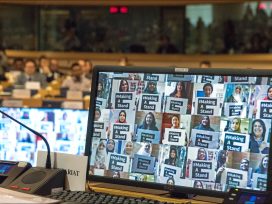Islamic acts of terror in Algiers, reports about the destruction of Buddha statues by the Taliban in Afghanistan, increasing persecution of critics of the regime in Iran… The international headlines are filled with news of the social consequences of politicised Islam. The emerging violence, the suffering of the victims, the opaque nature of the involved groups and their demands evoke reactions of incomprehension and horror. In contrast, Georg Stauth’s essays on the sociology of Islam provide the opportunity to reflect on these events from a distance. His book Islamische Kultur und moderne Gesellschaft (“Islamic Culture and Modern Society”) does not investigate the fundamental traits of Islam or its basic principles, nor does it endeavour to profile the goals and actions of fundamentalist groups. Rather, it concerns itself with the conditions and forms of dissemination of modern ideas of Islam in a context of cultural globalisation and social modernisation.
The texts are divided into four parts. They are based in part on empirical research done in Egypt and present methodological treatments of trans-cultural research (Part 1, Islam and the “Fundamentals” of Modernity) and theoretical reflections about globalisation and the sociology of Islam (Part 2, Modernity, Globalisation and Islam; Part 4, Islam and Sociology). The collection consists of lectures and essays which have appeared in various English and German language academic journals since the late 1980’s. The fact that these texts have in part been published some time ago does nothing to reduce their quality. On the contrary, in light of current developments they gain in clarity and make an important contribution of de-emotionalising the so-called fundamentalism debate by framing different ideas of Islam as modern self-descriptions.
The thesis running through the whole book is that the current developments in the Islamic world are expressions of cultural globalisation and are thus carried by general sociological categories. It finds its point of departure in the criticism of the “modern essentialisation of Islam” (see Part 1, Islam and the “Fundamentals” of Modernity). The author sees western-European and American journalists’ and academics’ views of the expressions of politicised Islam as a product of the “syndrome of introspective capture”, which is able to categorise religious behaviour of others only “in comparison to the values of strictest inner truth” and “closure”. The search for an authentic, “true” Islam blocks the view of the social processes that call forth the changing use of Islamic ideas. At the same time, this also meant that the relation of terminology and viewpoints remained unnoted a relation that is decisive to an understanding look at the Other (Islam) as well as to the “forms of control, destruction and subsequent reconstruction of culture” through this Other. Any sociology of Islam must therefore always be accompanied by a self-reflection on the analytical patterns and descriptions in cultural studies within the Muslim world. Why should globalised communication not change the culture and belief-system of the Other as much as it transforms the Christian religion?
Stauth argues, in a treatment of Luhmann’s concepts of system and lifeworld (published together with Hans-Günter Semsek) that the rural, traditional environment is destroyed by the “signals and images of consumerism” as much as the societies of the first world are. The dissolution of the internal structure of these social communities would lead to an externally guided rationalisation of “the villages” and thus to a simulative “idyllicising production of images” about the living-space, which can be radicalised by the social-religious movements. “The reality content, the deepening of meaning, is influenced by the production of images in systemic relation to the outside world” (p. 53).
Georg Stauth’s reading of Foucault’s reports on the Iranian revolution of 1978 illuminate a specific point of the instrumentalisation of Islam in the context of social processes of modernisation: that of the toppling of leadership and power structures by way of spirituality. The “untimely” and suppressed Islam is treated here as a religious technique of revolt. In the author’s view, the value of Foucault’s ideas lies in their having held on paper that spiritual forms of individuation hold a force for new forms of socialisation.
Georg Stauth sees cultural globalisation resting on an assumed European vision that has influenced the self-understanding of the Islamic world more strongly than its own historical memory has done. A historical perception assumed through colonialisation and cultural confrontation thus turned into the blueprint for the reconstruction of their own history. The “own” and “the foreign” are intertwined not to be disentangled again by the reproduction of symbols and contents of one’s “own” culture using “foreign” means. In the context of such structured politics of identity, charisma becomes a modern means of self-assertion, which has nothing to do anymore with the inner traits of Islam, whichever way they may be defined. The basic principles of Islam, analyses Georg Stauth, become empty verbal shells in “a universal fight for secular rationality of values” (see p. 100).
In the 1993 essay on “Islam as an identity of non-western modernity” (see p. 103-130), the author once again turns to the analysis of the changing relations between the “own” and the “Other” with respect to the relation between Islam and modernity from a viewpoint of Muslim thinkers. He investigates here the writings of three theorists, Fazlur Rahman (1919-1986), Malik Bennabi (1905-1973) and Ali Shari’ti (1933-1977), asking which attempts at modernisation and emancipatory demands have emerged within Islam. In this process, he finds the paradox that modernity’s emergence is based in part on the rise of religious fundamentalism, which in turn is today a sponsor for radical Islamic politics. One the one hand, one can thus read into the writings of the Islamic thinkers a criticism of the monopoly of orthodoxy and a “rational, utilitarian and functional re-interpretation” of the religious texts (see p. 122). On the other, however, the emergent utopia of the Umma, the community of believers, leads to a vision of collective self-description which makes a dynamic, productive relationship between the individual self and the order of state and law impossible. This ambiguity is instrumentalised by fundamentalist movements and politics by using rational, utilitarian and functional text interpretations in order to essentialise their own group. Georg Stauth sees in this process the generalised basic orientation of formal rationality and technology, which in turn provokes fundamental questions about difference in modernity. With this in mind, the author treats fundamentalism as a “multivariate production of modern self-perceptions” (see p. 134), which rest on the “moral transgression” of handed-down traditions and norms (see p. 148) and which present a transgression of lived value systems and life-styles (see p. 150). These theoretical thoughts and theses are illustrated and perceived as concrete practices in the three essays of Part 3, “Islamisation and Material Culture”, at hand of research done in Egyptian villages.
The fourth and final part of the book takes up once again the transformations of Islamic tradition from a sociological perspective, repeating in part theses from the previous texts. The author begins with a comparative reading from a theory-historical standpoint of Max Weber’s and Ignaz Goldziher’s sociologies of Islam. To Georg Stauth, both authors recognise the paradox of Islamic teaching, resting in the scholars’ openness toward the life and religious practices of local communities in contrast to the “scriptualised, textified and ritualised canon” of the teachings. Goldziher thus sees Islam as an alternative form of life in modernity, whilst Weber perceives in it the antithesis of modern life-forms (see p. 236-7). The classic religious sociological theories on Islam have, according to Georg Stauth, led to a scientific view which is caught on the one hand in its attempt to denote type and structure of Islam despite its perceived diversity and on the other in the dichotomy of modernity and pre-modernity. The author strives to break through this deadlock with new questions. In this context, he thus asks what happens to a “traditional religion” when it turns into a modern religion and thus replaces modern ideology in its societal function (see p. 240). Georg Stauth sees a new perspective for research here in the “sociology of the removal of borders”, which investigates how the internalisations of the idea “Islam” change amongst concepts of order and how local visions of order lead into differing ideas of Islam (see p. 258). What is decisive for the author here is the “re-evaluation of values” and transgression of common visions of order produced by the lifestyles and the widening of the social and geographical horizon, which go hand-in-hand with a “political rationalisation of religion” (see p. 255). During this process, the internalisation of Islam has multiplied in day-to-day interactions, which in turn have been directed by “cross-border”, universally effective dynamics of change. This factual differentiation of Islamic ideas and projects gives, in Stauth’s view, a strategic meaning to local communities; a meaning, which simultaneously points to the modern role of “Islam” (see p.266).





